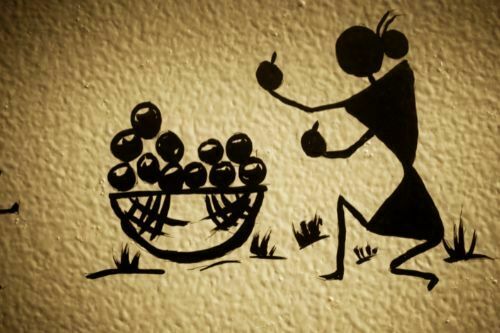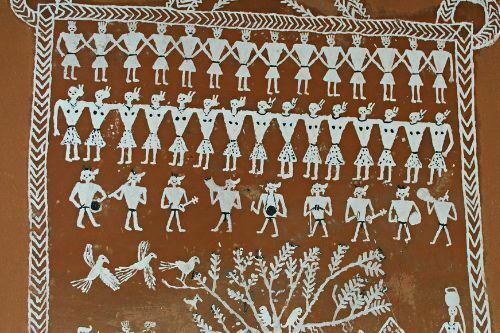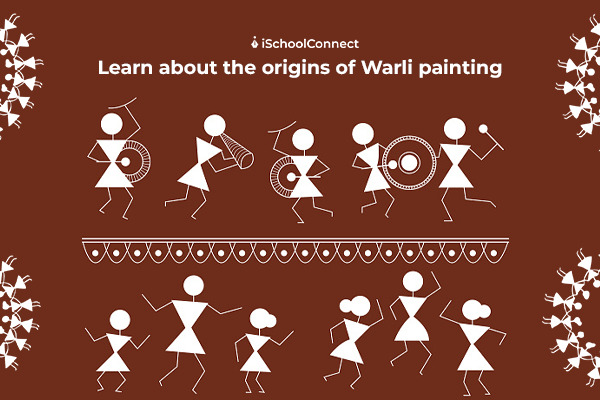Table of Contents
If you have ever tried sprucing your space with traditional art, you most definitely may have come across a Warli painting.
Warli painting is a traditional form of tribal art and is one of the oldest styles of painting in Indian history. These styles have now emerged to become one of the most popularly-appreciated artworks across the country.
Learning everything you need to know about Warli paintings can help you appreciate the intricacies of this beautiful art form.
Keep reading to learn more!
What are the characteristics of the Warli tribe?
Warli painting is a tradition that has evolved in the state of Maharashtra. The Warli tribe in India is one of the largest tribal communities in the country and is located on the outskirts of Mumbai.
The warli paintings by tribal folks typically belong to the northern region of the Sahyadri Range. This comprises districts such as Mokhada, Talasari, Dahanu, Palghar, and Jawhar.
The term ‘Warli’ is from ‘waral’, which means ‘a small piece of tilled land’. The art form that consequently emerged is heavily influenced by the tribes’ remarkable coexistence with the forests and nature.
The Warli tribe is found in Western India across the mountain ranges and coastal regions of the Gujarat-Maharashtra border.
The language spoken by the Warli tribe is ‘Varli’. This language is now classified as a Konkani language.
Traditionally, the Warli tribe was a semi-nomadic tribe that survived by hunting. The tribe is always led by one head.
Over the last couple of decades, the tribe has now evolved to take on a wide range of agricultural activities as a source of livelihood.
What is the tradition of Warli painting?

Warli paintings are often created using geometric shapes such as squares, triangles, and circles. These shapes are put together in different designs to create representations of the beliefs & lives of the Warli tribe.
Originally, Warli art was done on walls and only on special occasions. The painting would be created over a brown background. The background was often a mixture of cow dung cakes and mud. The white pigment that was used to draw the figures on this surface was made from a mixture of rice with gum & water.
What is the history of Warli painting?
While Warli paintings may seem like nothing more than figures drawn on a dark wall, a rich history lies behind these works of art.
The first discovered example of Warli art can be traced back to approximately 3000 BC. However, the different forms of Warli painting were not known until the 1970s.
While the Warli tribe’s primary way of life was farming & hunting, there was great respect for wildlife and nature. On several occasions, the creation of warli paintings is around the concept of Mother Nature and her elements.
A fascinating fact about Warli paintings is the usage of walls of clay huts as backgrounds. This is quite similar to how ancient human beings used the walls of their caves as canvases.
What are the different designs & styles of Warli paintings?

Warli paintings often depict a wide range of scenes and occasions. This art form uses basic geometrical shapes to represent nature. For example, a circle in a Warli painting represents the sun or moon. Triangles, on the other hand, are representative of trees & mountains.
Warli paintings also cover several day-to-day activities of the tribal people. These include performing rituals, dancing, and playing.
Some of the most common categories of Warli paintings are-
- Rituals
Rituals are arguably the most prominent of all the categories in Warli paintings. Several examples of the work showcase occasions, celebrations, day-to-day activities, and the joy of participating in rituals as a tribe.
One of the most popular themes in Warli paintings is a spiral chain of human beings around a central motif. This is a celebration of their belief that life is an eternal journey that does not have a beginning or end.
- Animals
Animals are a significant part of Warli paintings because of the close association that the tribe has with nature. Tigers are among the most popularly-painted animals in Warli painting.
- People
Warli paintings also depict the various characteristics of the tribal people, both good and bad.
- Gods
Finally, Warli paintings are around the old folklores of the tribe. Through this art form, the tribesmen beautifully depict their history and collective beliefs.
What are the most significant features of Warli paintings?
Warli paintings are often related to the daily events and rituals of the Warli tribe. Several of these paintings revolve around tribesmen dancing in spirals and open-ended circles.
Originally, Warli paintings were on walls. However, the background has now evolved to include other objects like-
- Dried bottle gourd
- Mud pots
- Cloth
- Dried bamboo
Initially, only tribe women called ‘savasini’ could create Warli paintings. However, this trend has now gradually shifted to include men.
The spherical patterns in most Warli paintings also represent the natural time cycle. The tribe is significantly close to natural life, as is depicted in designs of flora and fauna.
Key takeaways
- Warli paintings are among the most beautiful artworks to emerge from India.
- This style of art has a long and rich history that helps learn more about the Warli tribe and their beliefs.
- Warli art has now evolved to become one of the most popular folk arts used in industries such as interior design and clothing.
- Learning everything there is to know about Warli painting can help you better appreciate the intricacies and uniqueness of this style.
Was this blog informative? If so, please share your thoughts in the comments below. Click here to reach out to us for more information on Warli painting. We would be happy to assist you with your queries!
Liked this blog? Read next: Top universities to study arts | 10 must-know ones!
FAQs
Q1. Who popularized the Warli tribal art form?
Answer – Jivya Mashe popularized the Warli tribal art form. He was bestowed with the Padma Shree Award in 2011 for his efforts.
Q2. What does a square typically represent in Warli paintings?
Answer – Squares are representations of a sacred enclosure of a piece of tilled land.
Q3. How are Warli paintings created on a surface?
Answer – Warli paintings are created with a bamboo stick that is chewed on one end. This gives it a texture similar to a paintbrush.






